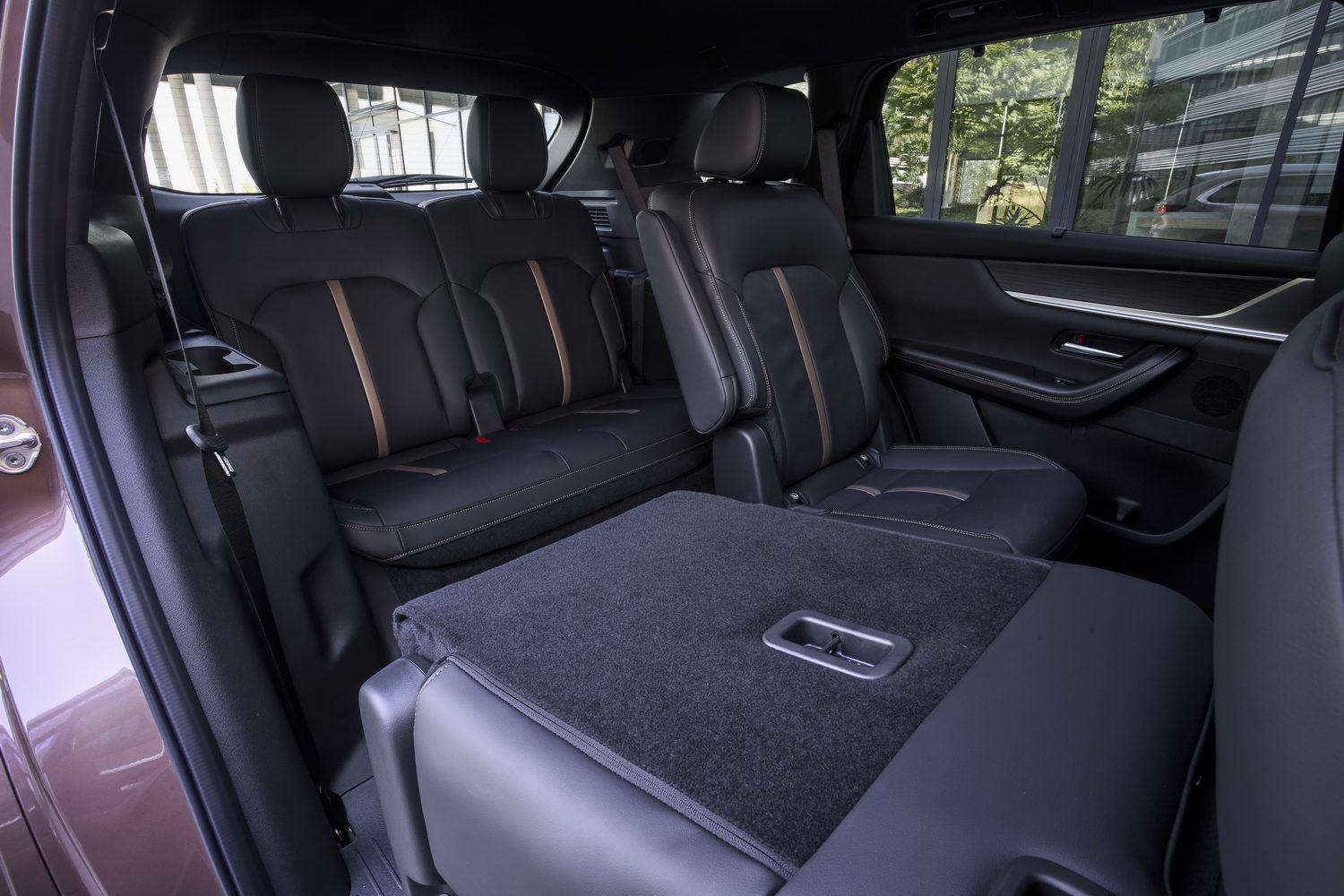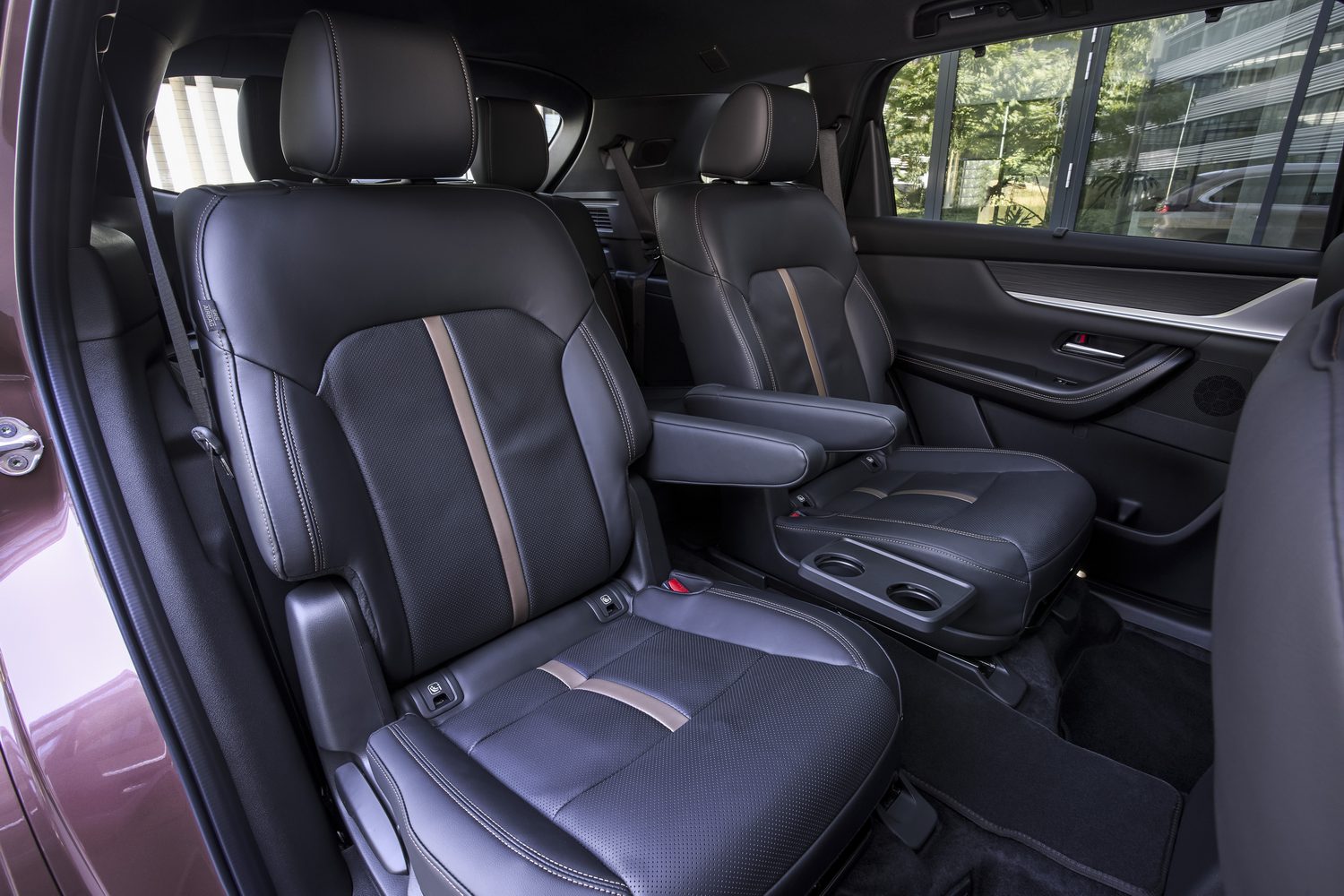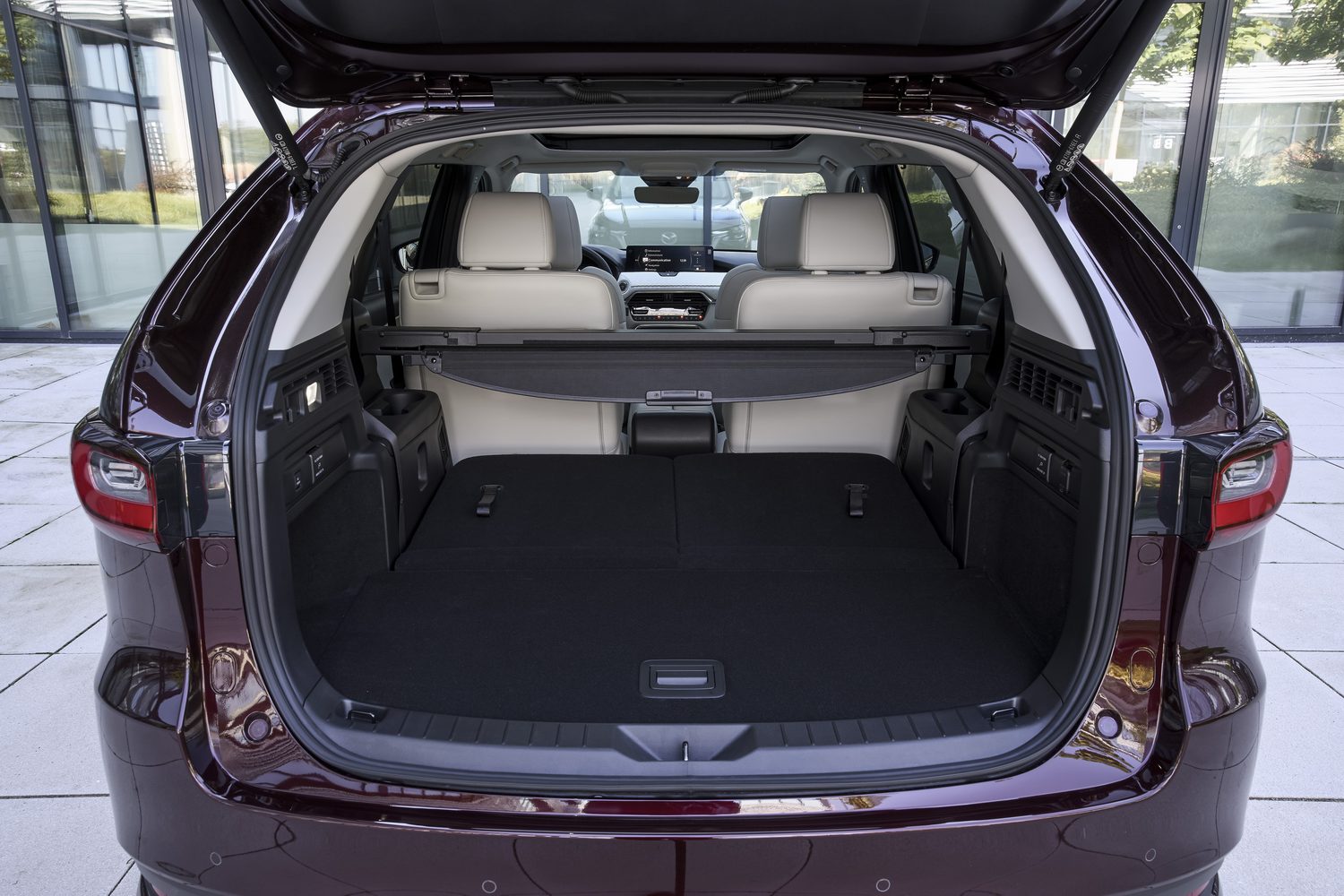If you’re looking at the Mazda CX-80 from dead ahead at the front, you’ll probably be thinking that you’ve made some sort of wrong turn in the showroom, and you’re actually looking at the Mazda CX-60. It’s OK, don’t worry: just lean slightly to one side, turn your head a little and... there you have it. This really is the CX-80 because while it shares a platform, engines, suspension, dashboard and styling at the front and rear with the Mazda CX-60, this is most definitely the bigger car - 250mm longer, all of that extra length going into the wheelbase. It’s Mazda’s biggest car right now and is designed to take on both the likes of the Skoda Kodiaq and Peugeot 5008 as well as offering a seven-seat alternative to the big posh German SUVs.

How much is the Mazda CX-80 in Ireland?
The CX-80 has a starting price for the plug-in hybrid version - with its VRT-friendly 35g/km CO2 emissions - of €61,380. That’s a lot of money, and it’s more than Skoda or Peugeot asks for their seven-seat SUVs. Then again, you can’t buy a seven-seat Skoda Kodiaq with the plug-in hybrid option (the battery takes up too much space) so while the Kodiaq PHEV offers almost double the Mazda’s range on one charge, it’s short two seats. Equally, if you wanted a seven-seat SUV from Audi, BMW, or Mercedes you’ll pay considerably more (excepting the Mercedes GLB, but that’s a smaller car by far) and in the case of the Audi Q7, again you can’t mix and match plug-in hybrid power with seven seats.

As standard, the CX-80 comes with seats for seven, but if you’re buying a Homura Plus or Takumi Plus model, it comes instead with a six-seat layout, with two ‘captain’s chairs’ in the middle row. Big 20-inch alloy wheels are standard, as are power-adjusted front seats (heated, too), a heated steering wheel, three-zone climate control, a 12.3-inch infotainment screen, built-in Amazon Alex voice control, cruise control and a head-up display.
How big is the Mazda CX-80?
The CX-80 is now the biggest car that Mazda sells in the European market, and it’s based on the same ‘Large Product Group’ version of Mazda’s Skyactiv architecture as the CX-60. It’s longer than the CX-60, by 250mm, bringing it to a total of 4,995mm in length, 1,890mm in width and 1,705mm in height.

By comparison, a Skoda Kodiaq is shorter, at 4,758mm, and a fraction lower at 1,659mm. A Hyundai Santa Fe is also a little shorter at 4,830mm, but it’s a little wider than the Mazda, at 1,900mm.
A look inside the Mazda CX-80
The interior of the CX-80 is unquestionably one of the car’s major high points, although it’s sensitive to spec. Basically, I’m going to tell you to buy a Homura or Homura Plus model and ignore all others. Why? We’ll come to that...
The dashboard is basically the same as that of the Mazda CX-60, so that means everything is well-made, and nicely laid-out. Mazda’s decision to keep proper physical controls for heating and air conditioning is a good one, while the main digital dials are simple and handsome, and the head-up display is useful.

There is a bit of a limitation though, which is that the CX-80 lacks storage space in the front of the cabin. All you get is two cup holders, a shallow storage bin under the front armrests, a wireless phone charging pad and some quite small door bins and that’s it.
At least there’s plenty of space in the back. The extra 250mm in the wheelbase means there’s leg-stretching space for even taller passengers in row two in the CX-60, especially if you have the captain’s chairs pushed all the way back on their 120mm slides. The seatbacks recline too, at up to 33 degrees, so you can sit in proper club-class comfort. To accentuate that effect, the top-spec Takumi Plus version comes with a console between the captain’s chairs, which houses cup holders and storage space.
I prefer the Homura Plus layout, with its walk-through space for the folding third row, making life slightly easier if you’re trying to get in and out of the way-back seats, helped by the massively long rear doors which open nice and wide and have integral sunshades as standard.

Those rear-most seats are well-upholstered, and there are USB sockets and air vents for the third row passengers, too, but if you want to fit in knees and feet, those sat in row two are going to have to budge up quite a bit, which detracts somewhat from the sensation of luxuriousness.
The boot is decent. With all seats in use, there’s a reasonable 258 litres left, which expands to a useful - if not quite massive - 687 litres with row three folded down (done by simply tugging a strap). Fold all the back seats and there’s a whopping 1,987 litres if you load the CX-80 to the roof.
Why go for Homura or Homura Plus spec, though? Simple - the colour scheme. The Takumi models use a very pale leather and blonde wood combo which, with massive bright chrome trim, makes the CX-80’s cabin appear far too gaudy to my eyes. Homura versions get black-and-beige leather with really nice contrast stitching, dark wood panelling and, instead of chrome, more subtle brushed gunmetal trim. It’s a far classier look in my opinion.

The Mazda CX-80’s on-board technology
Sharing with the CX-60 means that the CX-80’s tech is pretty familiar. The 12.3-inch screen in the centre of the dash is, technically, a touchscreen but mostly you use Mazda’s click-wheel controller down on the centre console which is far more sensible and safe when you’re on the move, as you can move around menus and options without taking your eyes off the road a lot.
The main instrument panel doesn’t offer much in the way of personalisation, but the graphics are clear and classy, and you can choose between round dials or a more expansive high-tech layout.

The built-in Mazda navigation has slightly old-school graphics, but the software now uses a combo of downloaded and cloud-based data to better swing you around traffic hot-spots, and which gives you a more accurate ETA when you have entered a destination. Amazon’s Alexa voice assistant is built-in (although of course you have to have an Amazon account to get the most from that) while there’s also a facial recognition system (which uses the driver drowsiness camera to recognise your face) which automatically loads up your seat and steering wheel position, your climate settings, and your infotainment preferences. Incidentally, the facial data is stored in the car, and not uploaded anywhere else.
The MyMazda app connects to the car, and in the PHEV model, allows you to control charging and cabin pre-conditioning, and it also works on Apple Watches now too. The standard Mazda Harmonic Acoustics audio system is a good one, but the upgrade to the more expensive Bose system is worthwhile if you’re a true audiophile. Wireless Apple CarPlay and Android Auto are standard, and PHEV models get a 1.5kW output socket in the boot, which can be used to charge up other electric devices (such as an e-scooter) or run domestic appliances (bring along your espresso machine for picnics).

Driving the Mazda CX-80
Once again, there’s familiarity here from the CX-60 as the CX-80 uses the same powertrains, either a plug-in hybrid or 3.3-litre straight-six mild-hybrid diesel. The diesel is a magnificent engine and, from our experience of driving it in the CX-60, exceptionally economical, but our first test drive of the CX-80 focused on the plug-in hybrid.
Performance-wise, it’s hard to argue with - 327hp is plenty, as is 500Nm of torque. The 129kW electric motor has plenty of power to push the CX-80 along at motorway speeds, as long as there’s sufficient charge in the battery, and switching the ‘MI-Drive’ selector to Sport mode opens up a rich seam of performance. The 2.5-litre four-cylinder petrol engine even manages to sound relatively sporty in its timbre when you rev it out. High Autobahn speeds were easily reached and maintained without much effort during our time with the car in Germany.

The PHEV system also juggles its power quite well. The braking also deftly balances energy regeneration to top up the battery and friction braking.
The CX-80’s chassis differs from that of the CX-60 in detail if not in overall design. The steering has been recalibrated, while at the rear the anti-roll bar has been removed entirely and the dampers have been stiffened up while the springs have been softened out. The suspension subframes have also been strengthened.
The product of all that work is a big SUV that handles with no small aplomb. OK, so you have to make appropriate allowances for the bigness, but the CX-80 has sweet, slightly heavy, steering and inherently good balance. It’s too big to be truly agile, but it feels more rewarding to drive than the Skoda Kodiaq, which is too light and too distant to be much fun. The Mazda, by contrast, can be fun in the right circumstances, and actually feels relatively similar to drive to the Audi Q7 in its overall sense of balance and steering precision. No bad thing.
While the CX-80’s longer wheelbase has smoothed out the ride comfort slightly, there’s too much crash and bang (both physical and audible) when tackling rough-edged surfaces. It’s a shame, as on a smooth road, the CX-80 is a consummate cruiser, refined and comfortable. It makes long motorway journeys just melt away, but then you’re reminded of its limitations as soon as the road becomes less than perfect.

How economical is the Mazda CX-80?
This is going to hugely depend on how you drive it and how diligent you are with keeping the hybrid battery charged. On a full charge, Mazda quotes up to 61km of electric range, and that seems broadly realistic. Figure on getting a reliable 50km out of a charge, as long as you’re not immediately hitting the motorway and cruising at 120km/h.
If you’re covering longer journeys in the PHEV, again keeping the battery topped up is critical. On our test drive, starting with a fully charged battery and driving in hybrid mode, we were able to cover quite long motorway stints at an average of 5.7 litres per 100km, which is not bad at all. Shorter journeys with reasonable battery charge and at lower speeds yielded more like 2.6 litres per 100km, and if you’re seeing that on a regular basis, I think you’d be pretty happy. Longer runs on a totally flat battery, though, won’t be as good - figure on 8.0 to 9.0 litres per 100km.
We haven’t yet had a chance to evaluate the diesel-engined CX-80, but our experience of that engine in the CX-60 suggests that the official average of 5.7 litres per 100km is achievable.
How many child seats can I fit in the Mazda CX-80?

As is the norm these days, the CX-80 only gets ISOFIX anchor points in the outer two rear seats. There are none for the front passenger seat nor the third-row seats, although of course you can fit child seats in those using the seatbelts. Loading up kids and their seats is made considerably easier thanks to those massive rear doors, and the step-through effect in the six-seat model.
How safe is the Mazda CX-80?
Euro NCAP hasn’t yet assessed the CX-80, but Mazda is anticipating a five-star score and has included some upgrades compared to the CX-60. Chief amongst these are tweaks to the lane-keeping steering and emergency braking systems which can better recognise an incoming frontal collision with oncoming traffic and both can alert, or brake and swerve, to mitigate or avoid those collisions entirely. There’s also a rear-seat alert to remind you to check the back seats for any dozing occupants, day-and-night functions for the pedestrian and cyclist detection, and a highly effective blind-spot monitoring system.
The reasons you'd buy a Mazda CX-80

The extra space available compared to the (not that much cheaper) Mazda CX-60 is welcome, as is the luxuriousness in the rear of the car, especially in six-seat mode. On smooth roads, the steering and suspension setup makes the CX-80 noticeably more engaging to drive than many rivals, and it’s a handsome car too. There’s also genuinely premium-level quality in the cabin, enhanced by the lovely darker, more subtle finishing in the Homura model. The plug-in hybrid version also has useful economy and electric range if you make the most of charging it up. It’s not, perhaps, the company’s most dramatic model, but the CX-80 is still rather appealing.
Ask us anything about the Mazda CX-80
If there’s anything about the CX-80 we’ve not covered, or you’d like advice in choosing between it and other cars, you can avail of our (completely free) expert advice service via the Ask Us Anything page.































